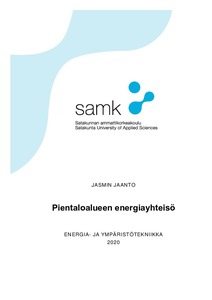Pientaloalueen energiayhteisö
Jaanto, Jasmin (2020)
Jaanto, Jasmin
2020
All rights reserved. This publication is copyrighted. You may download, display and print it for Your own personal use. Commercial use is prohibited.
Julkaisun pysyvä osoite on
https://urn.fi/URN:NBN:fi:amk-202004225643
https://urn.fi/URN:NBN:fi:amk-202004225643
Tiivistelmä
Tässä opinnäytetyössä tarkasteltiin pientaloalueen energiayhteisön toteutusmahdollisuutta kolmella vaihtoehtoisella tavalla. Energiayhteisötarkastelu rajoitettiin sähköenergiaan, joka tuotetaan aurinkoenergialla. Tarkastelu suoritettiin simuloimalla Excelillä kolme eri aurinkosähköjärjestelmäratkaisua. Ensimmäisessä vaihtoehdossa jokaiseen kiinteistöön asennetaan oma akullinen järjestelmä. Toisessa vaihtoehdossa kolme kiinteistöä jakavat yhden aurinkosähköjärjestelmän ja akun keskenään. Kolmannessa vaihtoehdossa energiayhteisöllä on yksi yhteinen aurinkosähköjärjestelmä ja akku.
Ratkaisussa, jossa jokaisella kiinteistöllä on oma järjestelmä ja akku, energiayhteisön sisäisiä synergiaetuja ei juuri saavuteta ja investointikustannukset ovat kalliit. Kiinteistökohtaiset järjestelmät poistavat kysyntäjouston haasteet. Edullisimmat investointikustannukset ovat koko energiayhteisön yhteisessä järjestelmässä. Myös huolto ja ylläpito on yksinkertaisempaa sekä laajentamismahdollisuudet ovat helpommat. Haasteena yhteisessä järjestelmässä on kysyntäjouston toteuttaminen. Vaihtoehdossa, jossa joka kolmanteen kiinteistöön asennetaan järjestelmä, on puolensa molemmista edellä mainituista järjestelmistä.
Opinnäytetyössä esitettiin lisäksi kaksi ehdotusta energiayhteisötoiminnan tasapuolisuuden mahdollistamiseksi. Ensimmäisessä vaihtoehdossa koko aurinkosähköjärjestelmän tuotto jaetaan tasan energiayhteisön jäsenten kesken ja hyvityslaskentamallin avulla kulutukset tasataan. Toisessa vaihtoehdossa energiayhteisön osakkuudet määritellään sähkönkulutuksen suuruuden mukaan. The purpose of this thesis was to explore the feasibility of implementing an energy community in a detached house area in three alternative ways. The energy community review was limited to electricity generated from solar energy. The review was performed by simulating three different photovoltaic system solutions in Excel. In the first option, each property has its own photovoltaic system and a battery. In the second option, three properties share one photovoltaic system and a battery. In the third option, the energy community has one shared photovoltaic system and a battery.
In a solution where each property has its own system and battery, synergy benefits are hardly achieved, and the investment costs are high. The benefit is that there are no challenges of demand response. The most inexpensive investment costs are in one common PV system and battery for the entire energy community. Service and maintenance are simpler, and expansion is easier to implement in the future. The challenge in the shared system is to implement demand response. The option of installing a solar system in every third property has positive and negative sides of both of the above systems.
In this thesis were made two proposals to enable equal function of the energy community. In the first option, the yield of the PV system is shared equally between energy community members and some kind of compensation model is used to offset consumption. In the second option, the shares of the energy community are defined by the amount of electricity consumed.
Ratkaisussa, jossa jokaisella kiinteistöllä on oma järjestelmä ja akku, energiayhteisön sisäisiä synergiaetuja ei juuri saavuteta ja investointikustannukset ovat kalliit. Kiinteistökohtaiset järjestelmät poistavat kysyntäjouston haasteet. Edullisimmat investointikustannukset ovat koko energiayhteisön yhteisessä järjestelmässä. Myös huolto ja ylläpito on yksinkertaisempaa sekä laajentamismahdollisuudet ovat helpommat. Haasteena yhteisessä järjestelmässä on kysyntäjouston toteuttaminen. Vaihtoehdossa, jossa joka kolmanteen kiinteistöön asennetaan järjestelmä, on puolensa molemmista edellä mainituista järjestelmistä.
Opinnäytetyössä esitettiin lisäksi kaksi ehdotusta energiayhteisötoiminnan tasapuolisuuden mahdollistamiseksi. Ensimmäisessä vaihtoehdossa koko aurinkosähköjärjestelmän tuotto jaetaan tasan energiayhteisön jäsenten kesken ja hyvityslaskentamallin avulla kulutukset tasataan. Toisessa vaihtoehdossa energiayhteisön osakkuudet määritellään sähkönkulutuksen suuruuden mukaan.
In a solution where each property has its own system and battery, synergy benefits are hardly achieved, and the investment costs are high. The benefit is that there are no challenges of demand response. The most inexpensive investment costs are in one common PV system and battery for the entire energy community. Service and maintenance are simpler, and expansion is easier to implement in the future. The challenge in the shared system is to implement demand response. The option of installing a solar system in every third property has positive and negative sides of both of the above systems.
In this thesis were made two proposals to enable equal function of the energy community. In the first option, the yield of the PV system is shared equally between energy community members and some kind of compensation model is used to offset consumption. In the second option, the shares of the energy community are defined by the amount of electricity consumed.
